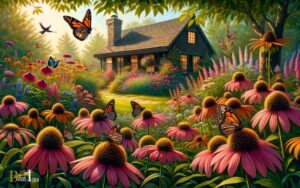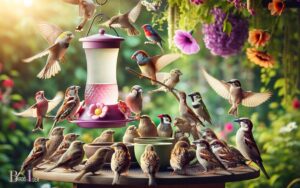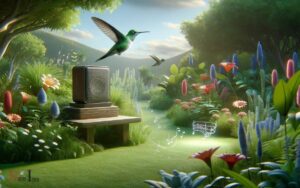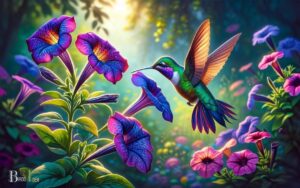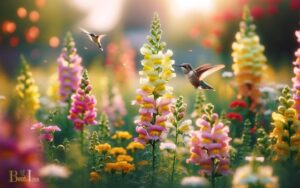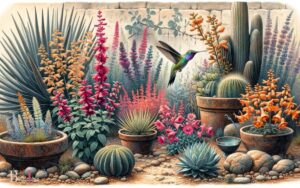Are Hummingbirds Attracted to Mandevilla? Yes!
Yes, Hummingbirds are attracted to Mandevilla plants. The tubular-shaped flowers of Mandevilla produce nectar, which is a primary food source for hummingbirds.
The vibrant and colorful blooms of Mandevilla, especially in shades of red and pink, are particularly appealing to hummingbirds.
The tubular structure of the flowers accommodates the hummingbird’s long beak, allowing them easy access to the nectar.
Planting Mandevilla in your garden can attract hummingbirds, providing both a visual spectacle and a food source for these energetic birds.
Overall, Mandevilla can be an excellent choice to attract hummingbirds to your outdoor space.
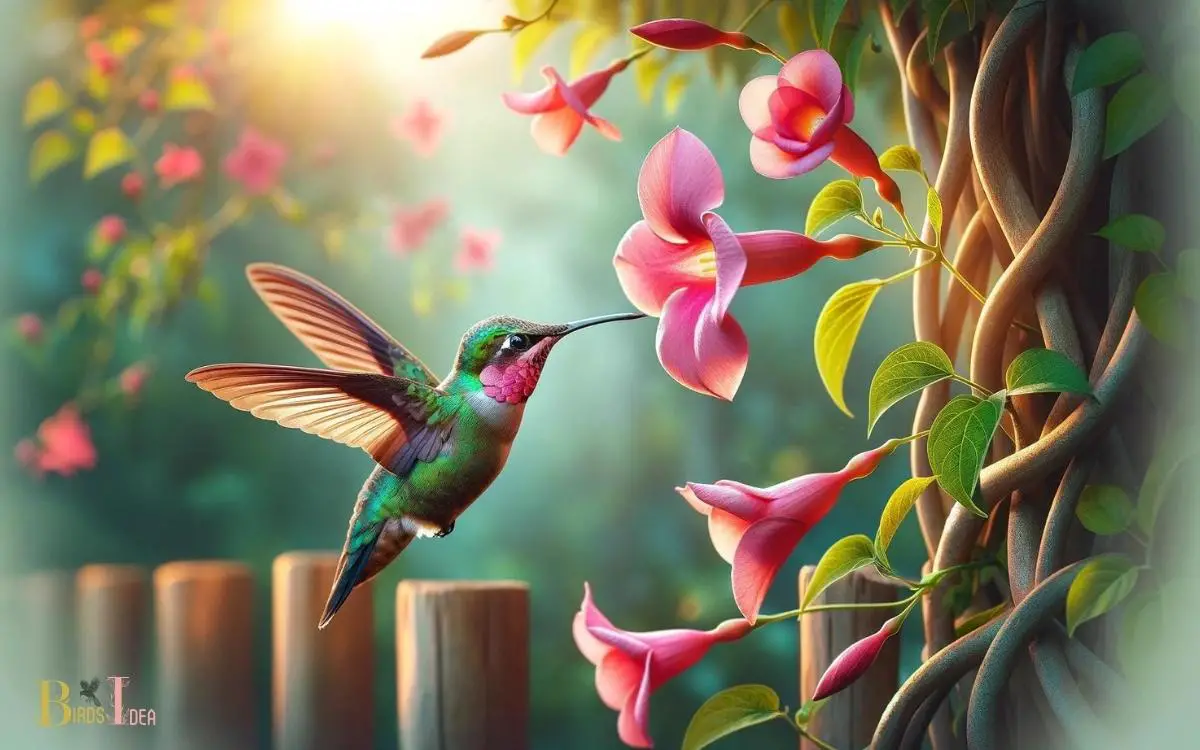
Key Takeaway
The Characteristics of Mandevilla Flowers
Mandevilla flowers are known for their vibrant colors and trumpet-shaped blooms, making them an attractive choice for hummingbirds.
These flowers come in various shades of pink, red, and white, with glossy, leathery leaves that provide an appealing backdrop.
The trumpet-shaped blooms, often around 3-4 inches in size, are perfectly designed for hummingbirds to access the nectar within.
Mandevilla flowers also have a mild, pleasant fragrance that can further attract these tiny birds.
Their long blooming period, from spring to fall, provides a consistent nectar source for hummingbirds.
Additionally, the tubular shape of the flowers provides a convenient landing and perching spot for hummingbirds while they feed, making Mandevilla a practical and visually appealing choice for any garden aiming to attract these delightful birds.
Understanding Hummingbird Behavior
Hummingbirds are known for their rapid wingbeats and hovering ability, allowing them to feed on nectar from flowers.
Understanding their feeding habits is crucial for attracting them to specific plants, such as Mandevilla.
By observing their behavior and preferences, gardeners can strategically plant flowers that are most attractive to hummingbirds, creating a welcoming environment for these fascinating creatures.
Hummingbird Feeding Habits
Understanding the feeding habits of hummingbirds can provide valuable insights into their behavior and preferences.
Hummingbirds are fascinating creatures with unique feeding behaviors:
- High Metabolism: Hummingbirds have a remarkably high metabolism, requiring them to feed frequently throughout the day.
- Nectar Preference: They are primarily attracted to brightly colored, tubular flowers that produce ample nectar.
- Hover-Feeding: Hummingbirds have the remarkable ability to hover in the air while feeding, thanks to their rapid wing beats.
- Insect Consumption: In addition to nectar, hummingbirds also consume insects for protein and other essential nutrients.
These behaviors showcase the specialized adaptations that hummingbirds have developed for efficient feeding and energy acquisition.
Understanding these habits is crucial for creating an environment that attracts and sustains these remarkable birds.
Attracting Hummingbirds With Plants
With their unique feeding behaviors in mind, it is important to select plants that cater to the nectar preferences and feeding habits of hummingbirds.
Hummingbirds are attracted to a variety of flowers that provide ample nectar, with a preference for tubular-shaped blooms that accommodate their long, specialized bills.
Brightly colored flowers, particularly those in shades of red, orange, and pink, are especially attractive to hummingbirds.
These colors are easily visible to the birds, acting as beacons to guide them towards potential nectar sources.
Additionally, plants that offer a consistent and reliable nectar supply, such as salvia, bee balm, and trumpet vine, are highly appealing to hummingbirds.
Understanding these preferences and selecting plants accordingly can significantly increase the likelihood of attracting these delightful creatures to your garden.
Mandevilla’s Nectar Production
Mandevilla’s nectar production plays a crucial role in attracting hummingbirds to the plant. The nectar, with its high sugar content, serves as a valuable food source for these tiny birds, encouraging them to visit the Mandevilla flowers frequently.
Here are some key points about Mandevilla’s nectar production:
- Abundance: Mandevilla plants produce abundant nectar, providing a reliable food source for hummingbirds.
- Composition: The nectar contains a high concentration of sucrose, glucose, and fructose, meeting the energy needs of hummingbirds.
- Color: The nectar is clear and has no noticeable color, making it easily accessible to hummingbirds.
- Accessibility: The nectar is located in the base of the flower, easily accessible to the long, slender beaks of hummingbirds.
This nectar production is an essential factor in attracting and sustaining hummingbird visits to Mandevilla plants.
Hummingbird-Friendly Planting Tips
Hummingbirds are attracted to a variety of flowers, and planting for bird attraction involves selecting plants with tubular flowers that hold nectar.
Mandevilla is known for its vibrant and trumpet-shaped blooms, making it a suitable choice for attracting hummingbirds to the garden.
When creating a hummingbird-friendly garden, it’s essential to consider factors such as the plant’s nectar production, blooming period, and the overall landscape design to provide a welcoming environment for these fascinating birds.
Mandevilla for Hummingbirds
Mandevilla planting for hummingbirds requires strategic placement and thoughtful selection of nectar-rich flowers.
When creating a hummingbird-friendly environment with Mandevilla, consider the following tips:
- Choose the Right Variety: Opt for Mandevilla species with trumpet-shaped flowers that are rich in nectar, such as Mandevilla sanderi or Mandevilla boliviensis.
- Strategic Placement: Plant Mandevilla near other nectar-rich flowers to create a continuous food source for hummingbirds.
- Provide Support: Install trellises or other structures for Mandevilla to climb, offering perches for hummingbirds to rest and observe their surroundings.
- Maintenance: Regularly prune Mandevilla to promote new growth and abundant flowering, ensuring a fresh supply of nectar for visiting hummingbirds.
Planting for Bird Attraction
The selection of nectar-rich flowers and strategic placement are crucial factors in creating a hummingbird-friendly environment in a garden.
When planting for bird attraction, it’s essential to choose flowers that are rich in nectar, such as bee balm, cardinal flower, and trumpet vine. These flowers provide the high-energy nectar that hummingbirds need.
Additionally, planting a variety of flower shapes and colors can attract a diverse range of hummingbird species. Strategic placement of these nectar-rich flowers is also important.
Placing them in clusters or near feeders and bird baths can create hotspots for hummingbird activity.
It’s also beneficial to plant these flowers in areas with some protection from strong winds, as this can make it easier for hummingbirds to feed.
By considering these factors, one can create an optimal environment for attracting and sustaining hummingbirds in their garden.
Tips for Hummingbird-Friendly Plants
When considering creating a hummingbird-friendly garden, it’s important to look for plants with nectar-rich flowers that are both attractive to hummingbirds and suitable for planting in your specific region.
Hummingbird-friendly planting tips include:
- Opt for native plants: Choose local flowers and shrubs that are naturally found in your region, as they are well-suited to the climate and soil conditions.
- Select a variety of bloom times: Include plants that flower at different times throughout the year to provide a consistent nectar source for hummingbirds.
- Prioritize tubular flowers: Hummingbirds are drawn to tubular-shaped flowers, such as salvia and penstemon, which are adapted for their long, specialized beaks.
- Avoid pesticides: Opt for organic gardening methods to ensure the nectar and insects that hummingbirds rely on are free from harmful chemicals.
These tips will help create a vibrant and sustainable environment for hummingbirds in your garden.
Attracting Hummingbirds to Your Garden
Hummingbirds are attracted to gardens with an abundance of bright, tubular flowers. These petite birds have a strong preference for red, orange, and pink flowers, with tubular shapes that allow them to easily access nectar with their long bills.
Some popular hummingbird-friendly plants include bee balm, salvia, and trumpet vine. It’s important to have a variety of flowers that bloom at different times throughout the year to provide a continuous nectar source for these energetic birds.
Additionally, incorporating native plants into the garden can be particularly attractive to hummingbirds, as they have co-evolved with these plants and are well adapted to feed from them.
By creating a diverse and colorful garden with an array of tubular flowers, one can effectively attract and support hummingbirds in their natural habitat.
Mandevilla Varieties for Hummingbirds
Attracting hummingbirds to your garden with mandevilla varieties involves selecting the appropriate flower colors and shapes to cater to their nectar-feeding preferences.
When choosing mandevilla varieties for hummingbirds, consider the following:
- Brightly colored blooms: Opt for mandevilla varieties with vibrant red, orange, or pink flowers to attract hummingbirds.
- Tubular flower shapes: Hummingbirds are drawn to tubular-shaped flowers, so look for mandevilla varieties with this characteristic.
- Abundant nectar production: Select mandevilla varieties known for producing ample nectar to provide a valuable food source for hummingbirds.
- Long blooming period: Choose mandevilla varieties that have a long flowering season to ensure a continuous nectar source for hummingbirds.
Conclusion
Mandevilla flowers have characteristics that make them attractive to hummingbirds. With their vibrant colors and nectar production, they are a great addition to any garden looking to attract these beautiful birds.
By understanding hummingbird behavior and planting mandevilla in the right location, gardeners can create a hummingbird-friendly environment.
So, why not add some mandevilla to your garden and see if you can attract these delightful creatures?

